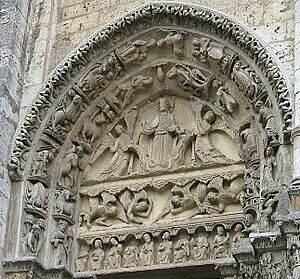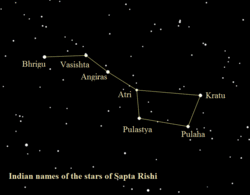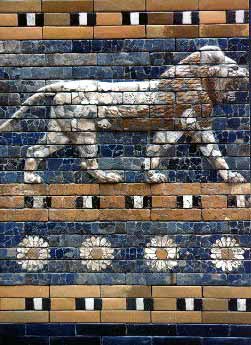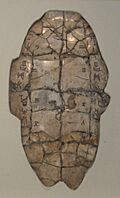History of astrology facts for kids
Astrology is a very old idea that connects what happens in the sky with events on Earth. People have believed in astrology for thousands of years. It has shaped how people see the world, their language, and many parts of their culture.
The first signs of astrology in some parts of the world go back to 3000 BC. It started with systems used to predict seasonal changes. People also thought that movements in the sky were messages from gods. For a long time, until the 1600s, astrology was seen as a serious subject. It even helped astronomy grow. Many leaders and important people believed in it. Some of its ideas were used in other studies like alchemy and medicine.
But by the late 1600s, new scientific ideas, like the idea that the Earth goes around the Sun (heliocentrism), changed how people viewed astrology. It stopped being seen as a serious academic study. Today, science shows that predictions made by astrology are not accurate.
In the 1900s, astrology became popular again with things like newspaper horoscopes. These are short predictions based on your birth date. Basically, astrology tries to find meaning for humans by looking at the sky. It tries to understand how planets and other space objects might affect people's lives.
Some people think astrology began when humans first tried to track changes in seasons using the sky. Early signs of this are marks on bones and cave walls. These show that people were watching the Moon's cycles 25,000 years ago. This was the first step to understanding the Moon's effect on tides and creating calendars.
Later, during the Neolithic Revolution, people learned more about constellations. They noticed how star groups appeared in the night sky with the seasons. This helped them know when annual floods or important activities would happen. By 3000 BC, many civilizations knew a lot about sky cycles. They even built temples to line up with the rising of certain stars.
There is some evidence that the oldest astrology texts are copies from this time. These are mainly from Mesopotamia (like Sumer and Babylonia). Some texts from Babylon around 1700 BC mention earlier records from the time of King Sargon of Akkad (2334–2279 BC). Another text from the Sumerian ruler Gudea of Lagash (around 2144–2124 BC) talks about gods showing him which constellations were best for building a temple.
Contents
Ancient Babylonian Astrology
Babylonian astrology is the oldest known organized system. It started around 2000 BC. Some think astrology existed in Sumer even earlier, but there isn't enough proof of a full system then. So, the history of serious sky predictions usually begins with texts from around 1800 BC.
By the 1500s BC, people widely used astrology to predict events. A huge collection of 70 cuneiform tablets called Enuma Anu Enlil contained 7,000 sky predictions. Texts from this time also mention older spoken traditions. At first, Babylonian astrology was only about predicting weather and political events. Before the 600s BC, their understanding of astronomy was simple.
Astrology symbols probably showed seasonal tasks. They were like a yearly calendar to remind people what to do, like harvesting or fishing. By the 300s BC, Babylonians could calculate where planets would be in the future quite well.
Babylonian astrology grew from divination, which is trying to find out the future. Old texts from around 1875 BC show how they interpreted marks on animal livers. These marks were seen as messages from the gods to the king.
People also believed that gods appeared as planets or stars. Bad signs from a planet meant the god it represented was unhappy. To fix this, people would try to please the god. They would also find ways for the god's message to happen without harming the king or nation. For example, a report to King Esarhaddon about a lunar eclipse in 673 BC shows how they used "substitute kings." This meant someone else would act as the king during a bad event to protect the real king.
Historian Ulla Koch-Westenholz says that Babylonian sky divination was objective. It followed known rules and its information was seen as true for everyone. She also notes that ancient Babylonian astrology was mainly about countries, cities, and kings. It was only later, from the 500s BC, that astrology started to focus on individual people's lives.
Astrology in Ancient Egypt
In 525 BC, the Persians took over Egypt. So, it's likely that Mesopotamian ideas influenced Egyptian astrology. For example, the Egyptian zodiac shared two signs, the Balance and the Scorpion, with Mesopotamia.
When Alexander the Great conquered Egypt in 332 BC, Greek culture became very important. In the city of Alexandria, scholars mixed Babylonian astrology with Egyptian traditions. This created Horoscopic astrology. This new system included the Babylonian zodiac and its ideas about planets. It also used the Egyptian idea of dividing the zodiac into 36 parts called decans. Each decan was 10 degrees.
Decans were used to measure time based on constellations. The rising of a constellation just before sunrise was seen as the last hour of the night. Over the year, each constellation rose this way for ten days. When they became part of astrology, each decan was linked to ten degrees of the zodiac. The oldest zodiac found in Egypt is the Dendera Zodiac, from the 1st century BC.
Ptolemy, a Greek-Roman astrologer and astronomer in Alexandria, was very important. His book Tetrabiblos became the foundation of Western astrology. It was almost like a "Bible" for astrologers for over a thousand years. This book was translated into Latin in 1138 and spread across Europe.
Ancient texts also say that the system of horoscopic astrology was given to an Egyptian pharaoh named Nekauba and his priest Petosiris. The Hermetic texts were also written around this time. These texts were very important for astrologers to know.
Astrology in Greece and Rome
When Alexander the Great conquered Asia, Greeks learned about the cultures of Syria, Babylon, and Persia. Greek became the main language for sharing ideas. This helped astrology spread from cuneiform texts to Greek. Around 280 BC, a priest from Babylon named Berossus moved to the Greek island of Kos. He taught Greeks about astrology and Babylonian culture. This made the Greek and Egyptian world a new center for astrology.
According to historian Nicholas Campion, the astrology that came from the East was very complex. Two main types of astrology appeared. One used horoscopes to find exact details about the past, present, and future. The other was "theurgic," which focused on the soul's journey to the stars. These two types were not completely separate. One sought information about life, while the other focused on personal change.
Greek influence was key in bringing astrology to Rome. At first, it was popular among common people. Romans were worried about people relying too much on Babylonian "star-gazers." In Greece and Rome, Babylon was so linked to astrology that "Chaldean wisdom" became another name for using planets and stars for divination.
The first clear mention of astrology in Rome is from Cato the Elder in 160 BC. He wrote a warning for farm managers not to ask Chaldeans for advice. The Roman poet Juvenal also complained about how widespread Chaldean astrologers were, even though they had low social status.
Thrasyllus, an astrologer in the first century CE, brought Hermetic astrology to Rome. He was the astrologer for emperor Tiberius. Tiberius was the first emperor to have a court astrologer. His predecessor, Augustus, also used astrology to support his power. In the second century CE, the astrologer Ptolemy wanted to make horoscopes accurate. He started the first attempt to make an accurate world map. This was so he could chart the link between a person's birthplace and the sky. While doing this, he created the word "geography."
Even though emperors used astrology, it was also sometimes banned. In the 1st century CE, Publius Rufus Anteius was accused of helping an astrologer and asking for his own horoscope and that of Emperor Nero. At that time, astrology could lead to charges of magic and treason.
Cicero's book De divinatione (44 BCE) rejected astrology. It is a good source for understanding how Romans thought about science. The philosopher Sextus Empiricus also collected old arguments against astrology in his book Against the Astrologers.
Astrology in the Islamic World
Quick facts for kids
Abū Maʿshar
|
|
|---|---|

A Latin translation of Abū Maʿshar's De Magnis Coniunctionibus ("Of the great conjunctions"), Venice, 1515.
|
|
| Born | c. 787 |
| Died | c. 886 Wāsiṭ, Iraq
|
| Academic background | |
| Influences | Aristotle, al-Kindi |
| Academic work | |
| Era | Islamic Golden Age |
| Main interests | Astrology, Astronomy |
| Influenced | Al-Sijzi, Albertus Magnus, Roger Bacon, Pierre d'Ailly, Pico della Mirandola. |
Islamic scholars eagerly adopted astrology after the Arabs took over Alexandria in the 600s. The Abbasid empire was founded in the 700s. The second Abbasid caliph, Al Mansur, built the city of Baghdad as a learning center. He included a library and translation center called Bayt al-Hikma ('Storehouse of Wisdom'). This center helped translate many Greek astrology texts into Arabic.
Early translators included Mashallah ibn Athari, who helped choose the best time to found Baghdad. Another was Sahl ibn Bishr (also known as Zael). Their texts greatly influenced later European astrologers. Knowledge of Arabic texts began to reach Europe in the 1100s.
In the 800s, the Persian astrologer Albumasar was considered one of the greatest. His guides for training astrologers had a huge impact on Muslim thinkers. Through translations, they also influenced Western Europe. Albumasar's Introductorium in Astronomiam was a key source for bringing Aristotle's ideas back to medieval European scholars. Another important figure was the Persian mathematician and astrologer Al Khwarizmi.
Arabs greatly increased knowledge of astronomy. Many star names we use today, like Aldebaran and Vega, come from Arabic. They also developed the list of Hellenistic "lots," which are now known as Arabic parts.
Some Islamic scientists, like Avicenna, later argued against certain astrology practices. They said astrologers' methods were guesses, not based on proof. They also felt it went against religious views by suggesting God's will could be predicted. These arguments mainly focused on predicting specific events for individuals. They did not usually question things like medical or weather astrology, which were seen as part of natural science.
For example, Avicenna argued against astrology's practice. But he still believed that planets influenced life on Earth in a set way. He just thought humans couldn't understand this influence well enough to make exact predictions.
Astrology in Medieval and Renaissance Europe

While astrology thrived in the East after the Roman Empire fell, Western astrology became "fragmented and unsophisticated." This was partly because Greek scientific astronomy was lost and partly due to the Church's disapproval.
Translations of Arabic works began to arrive in Spain in the late 900s. In the 1100s, many astrology books from Arabia reached Europe. By the 1200s, astrology was a common part of medical practice in Europe. Doctors combined Greek medicine with star studies. By the late 1500s, doctors in Europe had to calculate the Moon's position before doing complex medical procedures.
Important works from the 1200s include those by British monk Johannes de Sacrobosco and Italian astrologer Guido Bonatti. Bonatti advised leaders in Italy. His astrology textbook Liber Astronomiae (written around 1277) was considered the most important Latin astrology work of the century. Dante Alighieri even mentioned Bonatti in his famous book Divine Comedy.

In medieval Europe, a university education had seven main areas, called the seven liberal arts. Each was linked to a planet. For example, grammar was linked to the Moon (the fastest moving). Astrology and astronomy were linked to Saturn (the slowest).
Medieval writers used astrology in their stories. Dante's Divine Comedy uses planetary links in its descriptions of Hell, Purgatory, and Paradise. For instance, the seven layers of Purgatory match the seven cardinal sins, which correspond to the seven classical planets. Geoffrey Chaucer also used astrological ideas in his works.
Chaucer's writings often mention astrology. He knew enough about it to write a Treatise on the Astrolabe for his son. He describes the start of the Canterbury Tales by noting the Sun's position in the Ram. He links "sturdy hardiness" to Mars and "clerkes" to Mercury. Later, in the early modern period, you can find astrology in the works of William Shakespeare and John Milton.
One of the first English astrologers to leave detailed notes was Richard Trewythian (born 1393). His notebook shows he had clients from all parts of society. This means many people in 15th-century England used astrology, not just scholars or politicians.
During the Renaissance, court astrologers used horoscopes along with new astronomical discoveries. Many famous scientists, like Tycho Brahe, Galileo Galilei, and Johannes Kepler, were also practicing astrologers.
By the end of the Renaissance, people trusted astrology less. This was because old ideas about physics were breaking down. The idea that the Earth was separate from the heavens was also rejected. Historian Keith Thomas explains that the world was now seen as a huge machine, not a small, connected organism. The idea that Earth was less important than heaven disappeared. At first, astronomers were slow to give up astrology. But by the 1700s, the serious study of astrology was mostly abandoned.
Astrology in India

The earliest use of astrology in India is from the Vedic period. Astrology, called jyotiṣa, is listed as a branch of the Vedas (ancient religious texts). The only surviving work from this time is the Vedanga Jyotisha. It has rules for tracking the Sun and Moon. The exact date of this work is unclear, but it might be from the 2nd millennium BC. Indian astronomy and astrology grew together.
The oldest book on Jyotisha, the Bhrigu Samhita, was written by the sage Bhrigu during the Vedic era. He is called the 'Father of Hindu Astrology'. He is one of the seven respected Vedic sages, called Saptarishi. These seven sages are also linked to the seven main stars in the Ursa Major constellation.
The history of modern horoscopic astrology in India is linked to how Indian and Greek cultures mixed. The oldest surviving books, like the Yavanajataka, are from the early centuries AD. The oldest astrology book in Sanskrit is the Yavanajataka ("Sayings of the Greeks"). It was written around 269/270 AD.
The Samhita (Compilation), written on tree bark, is said to contain five million horoscopes. These include everyone who has lived or will live. The first named authors writing about astronomy are from the 400s AD. This is when the classical period of Indian astronomy began. Important works include those by Aryabhata and Varahamihira.
Astrology in China
The Chinese astrology system is based on their own astronomy and calendars. It developed a lot during the Han Dynasty (2nd century BC to 2nd century AD).
Chinese astrology is closely linked to Chinese philosophy. It uses ideas like yin and yang and the wu xing (five elements). It also uses the 10 Celestial stems, the 12 Earthly Branches, and the lunisolar calendar. These ideas are not found in Western astrology.
Astrology was highly respected in China. Confucius is said to have respected it, saying: "Heaven sends down its good or evil symbols and wise men act accordingly." The 60-year cycle, which combines the five elements with the twelve animal signs of the zodiac, has been used in China since at least the Shang dynasty (around 1766 BC – 1050 BC). Oracle bones from that time have been found with dates from this 60-year cycle.
There is a discussion about whether Babylonian astrology influenced early Chinese astrology. Later, in the 500s, a translation of the Mahāsaṃnipāta Sūtra brought the Babylonian system to China. It didn't replace Chinese astrology, but it was mentioned in some poems.
Astrology in Mesoamerica
The calendars of ancient Mesoamerica (like Mexico and Central America) were based on a system used since at least the 500s BC. The earliest calendars were used by groups like the Zapotecs and Olmecs. Later, the Maya, Mixtec, and Aztecs used them. The Maya made the most advanced versions of these calendars. The Maya and Aztec calendars are the best understood.
The Maya calendar used two main systems. One tracked the solar year of 360 days. This was for farming and daily life. The other, called the Tzolkin, had 260 days and was for rituals. Both were linked to a complex astrology system for every part of life. Five days after a boy was born, Mayan astrologer-priests would create his horoscope. This would tell them what his future job would be: soldier, priest, or something else.
They also tracked a 584-day Venus cycle. Venus was seen as a bad influence. Mayan rulers often started wars when Venus rose. There is also evidence that the Maya tracked Mercury, Mars, and Jupiter. They also had a zodiac. The Mayan name for the constellation Scorpio was 'scorpion'. The name for Gemini was 'peccary'. Some other constellations were named after animals. The most famous Mayan astrology observatory still standing is the Caracol observatory in Chichen Itza, Mexico.
The Aztec calendar is similar to the Mayan calendar. It also has two main cycles of 360 days and 260 days. The 260-day calendar, called Tonalpohualli, was mainly used for telling the future. Like the Mayan calendar, these two cycles formed a 52-year "century."
See also
 In Spanish: Historia de la astrología para niños
In Spanish: Historia de la astrología para niños
- Astrology and science
- Classical planets in Western alchemy
- Jewish views on astrology
- List of astrological traditions, types, and systems
- Worship of heavenly bodies



